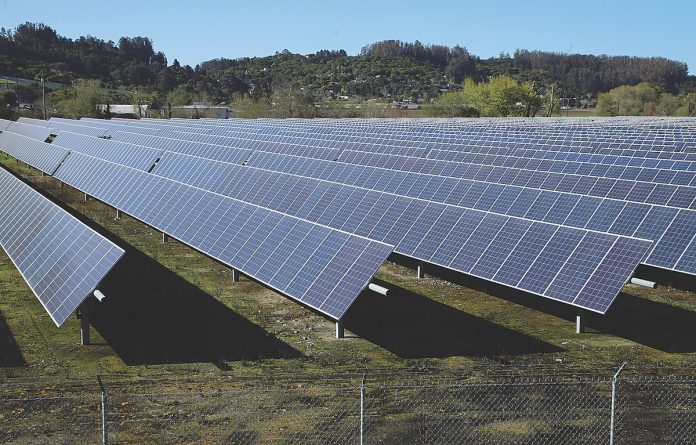AROMAS—The community of Aromas is home to about 2,650 residents. The rural area is nestled in the juncture between Monterey, San Benito and Santa Cruz counties, and attracts a variety of people, including many retirees, artists, farmers, nature lovers and activists.
But is also home to one of the region’s largest companies and consumers of electricity, Graniterock.
The contrast of Graniterock’s influence and the small community nearby has led to some disagreements over the years. However, a recent project involving both is showing just how much can be accomplished when the two work together.
In mid-March, Graniterock launched a massive, $15 million solar project. When complete, the 5-megawatt solar farm will include 15,000 photovoltaic solar panels on a 20-acre plot, and will power more than 60% of operations on the 121-year-old A.R. Wilson Quarry. The move will take both the company and Aromas one step closer to net-zero sustainability.
And it may not have happened without the backing and input of local environmental activists. In 2017, Seth Capron, a longtime Aromas resident and activist who is also vice chair of the Community Advisory Council for Central Coast Community Energy, met with Ben Eichert and Daniel Nelson of Greenpower, an arm of environmental justice nonprofit the Romero Institute.
The three discussed how they could transform Aromas into a net-zero community, and realized that starting with Graniterock would be a meaningful first step. Net-zero, used in this context, refers to achieving a balance between the greenhouse gasses released into the atmosphere and those taken out.
“Graniterock has large electrical loads, so it was a great place to start to really make a difference in terms of energy use,” Capron said.
Luckily for them, Graniterock was already heading in that direction. Capron learned that the company had installed a small solar array at the quarry and was looking for more ways to move toward sustainability. It had also transformed its corporate offices in Watsonville, utilizing solar energy, installing electric car charging stations and more.
They are even using greener concrete mixes. Jon Erskine, Director of Geological and Environmental Sciences at Graniterock and a major leader for the solar project, said that reducing the cement content of their concrete has helped lower the company’s overall carbon footprint.
“By going green, we are showing [everyone] that these are our values,” Erskine said. “Thankfully we’ve got a management structure that’s receptive to these ideas. That’s how these things happen.”
Leslie Austin, a clean energy organizer with Greenpower and member of the Aromas Progressive Action League’s (APAL) Climate Action Team along with Capron, said that they feel very lucky to have such a receptive ear in Graniterock.
“We didn’t have to sell it too hard,” Austin said. “They were already moving forward, ready to listen and take action.”
APAL is one of the main players in moving Aromas and Graniterock to net-zero status. They spent two years hosting public activities to improve energy efficiency, increase usage in renewables and encourage electric vehicles in local communities. All the while, they continued to have discussions with Graniterock about the solar project.
Eventually, these discussions also began to include Mynt Systems, a sustainable development and construction firm who focus on profitable decarbonization strategies for commercial-industrial facilities.
“This project proves that even the largest industrial power users can significantly reduce their carbon footprint while maintaining strong economics,” said Mynt’s Chief Development Officer Rob Hymes. What’s good for the planet is good for business and that is good for the whole community.”
Three years after the initial vision was formed, construction has started on the project. Keith Severson, Director of Marketing and Community Involvement at Graniterock, said that it is slated to be finished by early 2022 at the latest.
“This project is hugely significant. We’re obviously the largest power user in the area,” Severson said. “It means that we’re heading in the right direction of what industry should be doing. The company and the community will benefit, and the earth will benefit. It’s a win-win.”
Erskine said that as a company, Graniterock tries to be as transparent as possible—and a major part of that is working on staying connected and listening to the local community.
“This project ticks all the boxes—it’s green, it’s community supported and in the long run, it will result in financial savings,” Erskine said.
Capron said it was “very satisfying” accomplishing something so big so close to home.
“I’ve lived here a long time, since 1970,” he said. “The folks in Aromas… there’s a lot of caring people here who have gotten involved in really important issues, for the community and the environment.”
Added Austin: “Aromas is in a unique place, for better or worse. We don’t get the attention of the three counties we’re in, so we have to do things ourselves. And we do. I think this is proof of that.”










